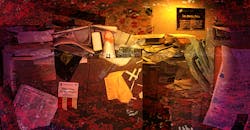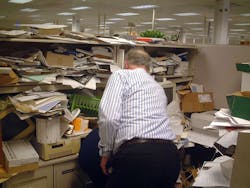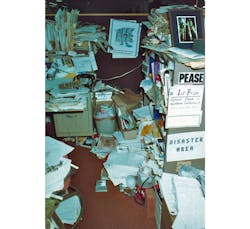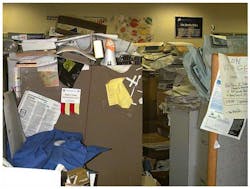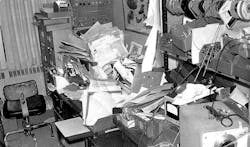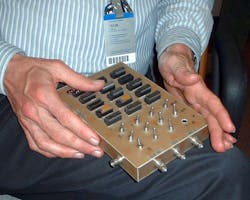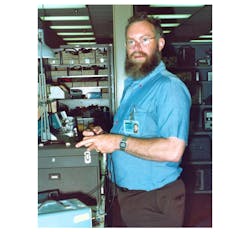Download this article in PDF format.
Bob Pease had a famously messy office (Fig. 1). In an article in these very pages, he described winning a contest for the ugliest desk in Northern California (Fig. 2). After he died in 2011, I made a video tour of Pease's office, circa 2008, set to music:
Pease’s office came to mind when I read an article claiming a messy desk may be a sign of genius. The article was based on a University of Minnesota study. As is often the case, the mainstream media article played up the more sensational aspect, that messiness was good. The study itself noted that while messiness can promote creative thinking, tidiness can encourage healthy habits, kindness, and conforming to established standards. As a recent convert to the KonMari method, I root for tidiness.
1. Bob Pease in his office in February of 2003. Incredibly, he seemed to know where everything was located. Here he is retrieving an obscure document I asked for. It was pretty deep in one of the stacks.
2. Pease’s office won a contest held by the San Jose Mercury News. It was for the ugliest desk in Northern California. Pease won $500 and took everyone to lunch. Note the copy of Electronic Design with the brown cover right in front of the wastebasket. (Courtesy of Fran Hoffart)
Decades ago, when I worked for Ford Motor in Dearborn, Mich., there was a fellow engineer who complained he never got promoted. His desk looked like Pease’s did back in the 1990s (Fig. 3). I took the fellow to the group leader’s office. It was noticeably neater. Then we went to the supervisor’s office. Neater still. We got up to the manager’s office and it was pin-neat. I didn’t have to take him to the VP’s office to make my point. If you can’t organize a desk, how can you organize a complex business? A sloppy desk is perceived by others as non-professional.
3. Bob Pease’s office in the 1990s. It was getting harder to walk inside. (Courtesy of Don Sauer)
Now engineers know that correlation is not causality. So you can’t simply claim that a messy desk makes you more creative. Pease I think was a special case since he was a hoarder (Fig. 4). My pal Alan Martin at Texas Instruments helped unload 140 boxes of paper from his house. Bob’s wife Nancy told me she would not recognize the house afterwards. She also mentioned to Alan Martin that there was “a second storage space” that Martin did not know about. It too was full of papers.
4. In February of 2003, Pease’s office was quite the fire hazard. There was a yearly battle with the Santa Clara fire marshal.
Is Sloppy a Good Thing?
Many have noted Albert Einstein's quote, “If a cluttered desk is a sign of a cluttered mind, of what, then, is an empty desk a sign?” Instead of the words cluttered and empty, you could use the words slob and organized. For some tasks, an organized mind is better than a creative one. This is especially true of the “herding cats” environment of some tech companies. While giving anecdotal evidence of the sloppy desks of great minds, this article is also suitably analog, noting that you have to strike a balance between the two extremes. Pease sure was at the extreme, even back in his Philbrick days in the 1970s (Fig. 5).
One thing I have noticed is that sloppy people are often marking their turf. They figure to make such a mess that no one would venture to use the space. Analog guru Jim Williams told me as much. I have seen pictures of Williams’ home lab and it was extremely organized and neat.
5. Bob Pease even had a messy office back in his days working for Philbrick in the 1970s.
I went through this “turf war” phenomena at a company I was working at. The lab was a total mess. I would clean off a bench and find some power supplies and a working, but dim, scope. The next day, some other engineer had appropriated it as his bench. I complained to the boss but he said I was the new guy and don’t get upset.
So I found another lab bench, cleared it off, and set it up with yet another scope, soldering iron, and power supply. A week later, another engineer had taken over my bench. He said, “Well it was so neat, I figured no one was using it.” Total lies, he knew just what he was doing. And like a true passive-aggressive, now he had the bench all set up for a test, and well, I couldn’t kick him off. I complained to the boss again. He replied with more mealy-mouthed dissembling. They offered me a job as lab manager. Great, house mother for infantile inconsiderate children. That’s not what I dreamed of when I was taking differential equations and control systems in college. I am a design engineer. I quit a month later.
That’s one problem with all the praise for messy desks. It always focuses on the individual, but never the impact on the organization. When Pease had to move into a different building, it was a huge effort for the facilities department and a huge imposition on those in the new office (Fig. 6).
6. When Bob Pease had to move to a different building, there was a mountain of paper and other paraphernalia that the facilities department had to deal with. (Courtesy of Fran Hoffart)
The facilities people dreaded when the fire marshal would come to inspect. They tried to keep him away from Pease’s office, but the word had gotten out. They usually impressed on Pease that he had to keep an aisle clear and that nothing could be stacked above the cubicle walls, since after all, this was earthquake country. Pease would make an effort to comply when faced with the prospect of being the guy that got the entire building condemned.
Mesmerizing Memory
Frank Zappa’s autobiography had a Flaubert quote put in by the ghostwriter. “Be regular and orderly in your life, so that you may be violent and original in your work.” One reason brilliant people can be slobs is because they often have an eidetic memory—they can remember the location of every single thing.
7. Here’s Bob Pease holding this neat and tidy test box in February of 2002. He was neat when other people needed it.
A co-worker of Pease told me that he went into Pease’s office and asked for some bond-out drawing for an old part Pease had worked on. Bob went to one of the many stacks on his reference table, went down about 10 inches, and pulled out the drawing on the first try. The co-worker made a copy, and gave the drawing back to Pease, who just plopped it on the top of another stack.
About six months later, the co-worker decided to give Pease a little test. He went back and said he lost the bond-out drawing and could he borrow it again. To his amazement, Pease went to the new stack, and this time went down about a half an inch, and pulled out the drawing. That is great and impressive, but I feel that if you can clear your head of clerical issues, you have more brainpower to do creative work.
8. Bob Pease selling some of his books at the August Silicon Valley Electronics Flea Market, aka the eFlea. There was no mess on this desk. He came to breakfast with the gang afterwards.
The odd thing was that Pease’s office and “air-ball” prototypes might be a mess, but he knew when he needed to make some neat, organized gizmo (Fig. 7). He would be especially diligent if the gizmo had to be used by other people. This is to his credit, that he did understand the utility of neatness. When he came down to the Silicon Valley Electronic Flea Market, he laid out his books in a perfectly orderly fashion, knowing that was the way to get them looked at and sold (Fig. 8).
Me, I am a binge slob. I get messier and messier, until I snap and then organize everything. Sometimes when faced with a daunting problem or task, I find a great way to start organizing my desk or my computer or my lab bench. It just seems I flow right into the job at hand. Of course, by the end of the job, everything is a mess again.
9. While his desk was messy, Pease dressed and acted neat, perhaps thanks to his wife, Nancy. He worked at National Semiconductor right up to when it was acquired by Texas Instruments. (Courtesy of Fran Hoffart)
So try and tolerate those messy co-workers, friends, and spouses. Some of us are hopeless like Pease, others get better and worse depending on mood or day of the year. All I know is I sure miss Bob Pease and his messy office (Fig. 9).
About the Author
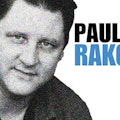
Paul Rako
Creative Director
Paul Rako is a creative director for Rako Studios. After attending GMI (now Kettering University) and the University of Michigan, he worked as an auto engineer in Detroit. He moved to Silicon Valley to start an engineering consulting company. After his share of startups and contract work, he became an apps engineer at National Semiconductor and a marketing maven at Analog Devices and Atmel. He also had a five-year stint at EDN magazine on the analog beat. His interests include politics, philosophy, motorcycles, and making music and videos. He has six Harley Sportsters, a studio full of musical instruments, a complete laboratory, and a video set at Tranquility Base, his home office in Sun City Center Florida.
